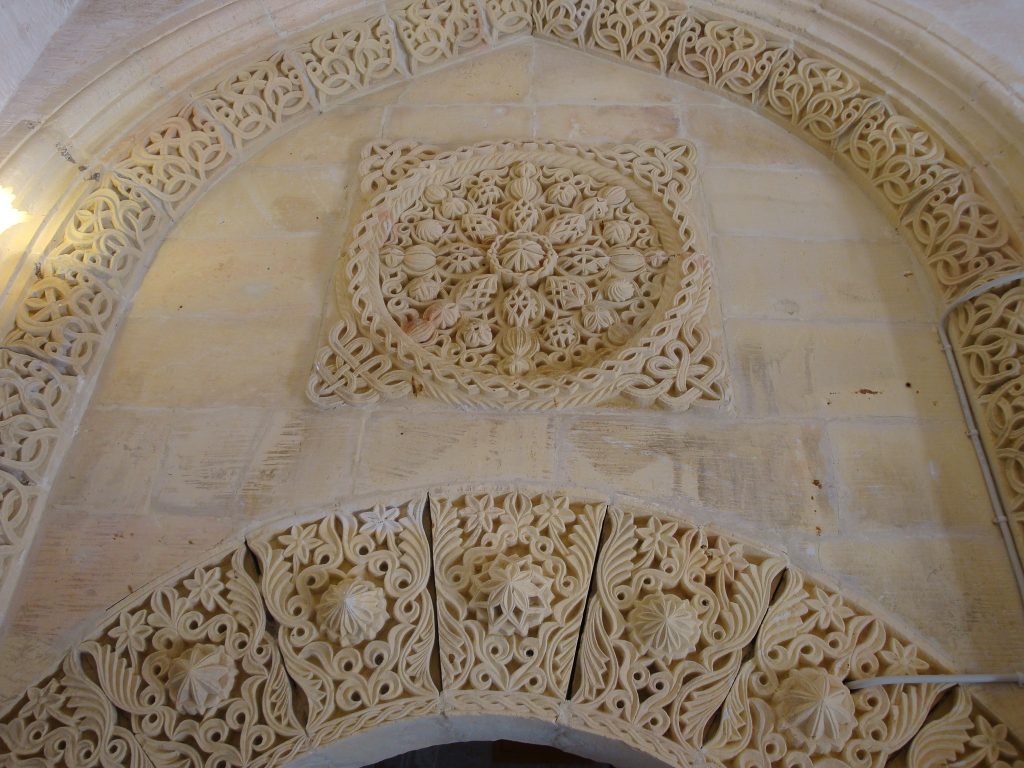Other names: Marıdın, Matedin, Merdo, Merdin, Erdobe, Merdine (Kurdish)
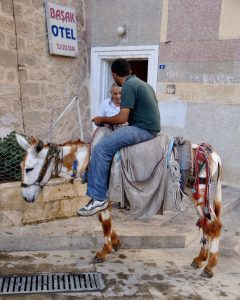 In the half light of early evening a large white donkey wobbles down the street with two gas canisters draped across its back. Behind it another waits patiently while its saddlebags are filled with building rubble. Then two boys come careening down the street on their animals and for a fleeting moment Mardin seems more like the Wild West than the wild east of Turkey, only with donkeys taking the place of the broncos.
In the half light of early evening a large white donkey wobbles down the street with two gas canisters draped across its back. Behind it another waits patiently while its saddlebags are filled with building rubble. Then two boys come careening down the street on their animals and for a fleeting moment Mardin seems more like the Wild West than the wild east of Turkey, only with donkeys taking the place of the broncos.
The donkeys are a symbol of one of modern Mardin’s biggest problems. Carved into the sides of a hill, it’s rightly famous for its lovely honey-coloured houses with frilly carvings around their windows, and for minarets with huge stone tears dropping down their sides. But getting to and from the houses involves much struggling along narrow alleyways and up and down stone staircases.
In the circumstances, how are the authorities to collect the rubbish? Their solution has been to licence a team of rubbish-collecting donkeys to spend their days fetching and carrying.
Through the lost years of the 1990s Mardin was a city more talked about than visited; a place which, with its arched passageways (abbaras) and colourful market, reminded its infrequent visitors of Old Jerusalem. But as the troubles in the east quietened down so it experienced a welcome new lease of life as Turks poured in to soak up its charms. For foreign visitors this boom is something of a two-edged sword since it can mean that reasonably priced bedrooms, not to mention tables at the best restaurant in town (the tiny Cercis Murat Konagı) are unexpectedly hard to come by.
So what does Mardin have to offer?
Increasingly this is a very two-faced town. As you drive towards it your heart may sink at the sight of yet another ugly new settlement built to accommodate a burgeoning population and you may find yourself mouthing a silent parody of John Betjeman’s famous condemnation of Slough: “Come, friendly bombs, and fall on Yeni Mardin (New Mardin)…” Then you glimpse the old city and all is forgiven.
One of the most surprising developments in this once blighted city is the blossoming of cafe society. In a town where until quite recently it was hard to get anything to eat after eight o’clock at night there are now plenty of places where it’s possible to while away as much time as you like over tea or coffee, be you male or female.
If it was Asmalı Konak that first turned Turks on to the beauty of Cappadocia, it was probably the Berevan and Sıla television serials that stamped Mardin on the mental maps of most Turks.
Don’t leave town without trying:
- dobo, stuffed lamb’s leg served on a bed of bulgur pilavı
- mırra kahvesi, bitter, coarsely-ground Turkish coffee, sometimes flavoured with cardamon and served with considerable ceremony
- kiliçe, biscuits flavoured with cardamon
Around town
Old Mardin sits on terraces on the hillside. Here Birinci Caddesi (First Road) straggles along one side of the hill with fine old buildings rising up and dropping down on either side of it. Up above stands the magnificent building that houses the local museum and what was once the most beautiful post office in all Turkey, worth visiting even if you had no urgent mail to despatch. Down below stands the wonderful 12th-century Ulu Cami and a set of tea gardens offering stupendous views over the undulating Mesopotamian Plain to distant Syria.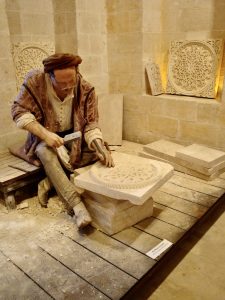
There are a few other specific sights to see around town, some of them ancient medreses and mosques, some of them more unexpected Syrian Orthodox churches that attest to the two religious traditions that have co-existed in varying degrees of harmony over the centuries.
The restored 15th-century Kasımıye Medresesi, with its cool courtyard pool, is tucked away on the outskirts of town but to find the twin-domed 14th-century Sultan İsa Medresesi you need only scramble up a few staircases from Birinci Caddesi. Don’t miss the mihrab in its mosque which incorporates some pieces of onyx apparently brought from Iran.
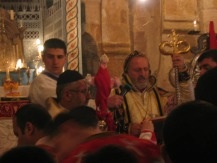 Easter at Kırklar KilisesiOf the churches perhaps the most interesting is the Kırklar Kilisesi (Forty Martyrs Church), worth visiting to glimpse the extraordinary hand-painted altar curtains that look as if they’ve strayed from Ethiopia. The last maker of these curtains, Nasra Şimmeshindi, died in 2016.
Easter at Kırklar KilisesiOf the churches perhaps the most interesting is the Kırklar Kilisesi (Forty Martyrs Church), worth visiting to glimpse the extraordinary hand-painted altar curtains that look as if they’ve strayed from Ethiopia. The last maker of these curtains, Nasra Şimmeshindi, died in 2016.
Probably the oldest church in Mardin is Mor Mihael on the outskirts of town where it sits hunkered down behind a protective wall. It may date back to the 5th century and is said to retain the base of a pillar for a stylite saint. The church is also known as the Burç (Tower) Monastery because a tower from the city walls was built into it; it now forms the platform for a 19th-century bell tower.
Mardin’s chaotic and colourful bazaar rambles along the streets immediately beneath Birinci Caddesi. Here, amid the usual stalls touting fruit and veg, cheap clothes and household goods, are far more exciting ones selling hand-stitched saddles, hand-beaten copper and finely carved wooden settles.
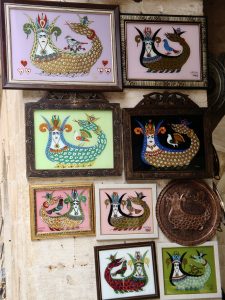 Even more intriguing are the shops where you can watch craftsmen painting colourful camaltı (under-glass) images of the Şahmaran, an enigmatic Mesopotamian fertility deity with the head of a woman and the body of a snake.
Even more intriguing are the shops where you can watch craftsmen painting colourful camaltı (under-glass) images of the Şahmaran, an enigmatic Mesopotamian fertility deity with the head of a woman and the body of a snake.
The town now has two museums: the state-run archaeology and ethnography museum housed in what was built in 1895 as a beautiful home for the Syrian Catholic Patriarch; and the privately-owned Sabancı Museum (both closed Mondays). Taken together they offer an insight into many aspects of local life, including the drinking of bitter mırra coffee.
Since the Syrian War led to massed exit into Turkey a wall has been built along the Turco-Syrian border. I don’t know if it is visible from Mardin.
Sleeping
Unless price is unimportant to you finding somewhere suitable to stay in Mardin can be problematic. During the 1990s few people came here so there was no point in anyone investing in the hotel stock. When that situation changed almost overnight in the 2000s a couple of boutique hotels put in an appearance and were quickly overwhelmed by the demand. Now new hotels are opening all the time, all of them are aimed at the well-heeled Turkish city-break market. This might not matter except for the fact that standards of service and cleanliness are not always as high as you might expect for the prices.
If you don’t book ahead you may arrive and find everything full. On the other hand if you do book ahead you risk arriving and finding that you have been given a room in a substandard annexe.
The magnificent building at the east end of Birinici Caddesi that used to serve as the post office now operates as an Uygulama Hotel (Training Hotel). You can stay in it although the impression I had was that standards might not be all that high and that you might have to endure loud noise from wedding parties using the same venue.
If everything is full it’s worth remembering that there is an Öğretmen Evi in the new town.
Artuklu Kervansaray. Tel: 0482-213 7353
Buday Butik Otel. Tel: 0482-212 8586
Büyük Mardin Hotel. Tel; 0482-213 1047
Dara Konağı. Tel: 0482-232 3272
İzala Boutique Hotel. Tel: 0482-212 7474
Otel Bilen, Yeni Mardin. Tel: 0482-213 0315
Reyhanı Kasr. Tel: 0482-212 1333
Zinciriye Otel. Tel: 0482-212 4866
Eating
Cercis Murat Konağı. Created by Ebru Baybara Demir in the early 2000s to showcase Mardin’s distinctive cuisine and still going strong, having played a big part in kick-starting Mardin’s tourism industry. Tel: 0482-213 6841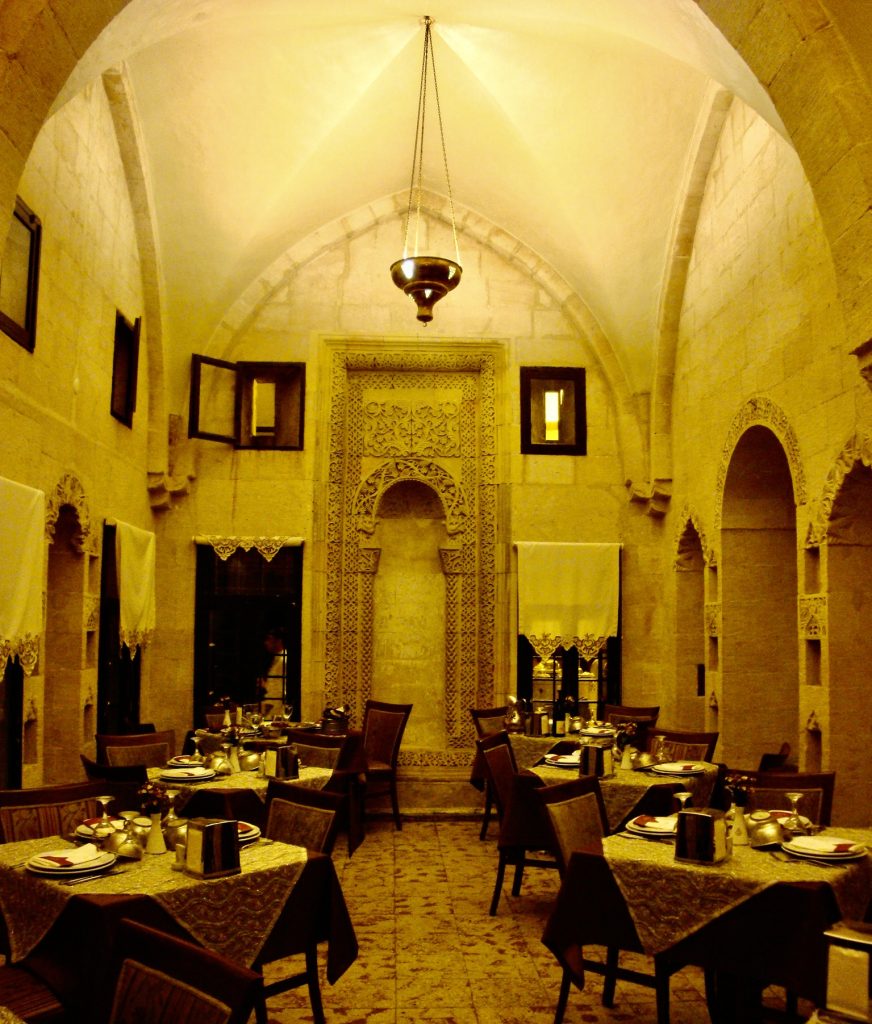
Transport info
The least stressful way to get to Mardin is to fly there from İstanbul or Ankara. On a longer trip there are plenty of inter-city buses from Şanlıurfa or local buses from nearby Diyarbakır and Midyat.
Local buses trundle along one-way Birinci Caddesi, the main street of the old city, dropping passengers off along the way. This is fine if you’re heading east from Diyarbakırkapı towards Meydanbaşı, not so good if you want to go the other way as you’ll have to go all the way round via the new city first.
The main dolmuş station is at Meydanbaşı in the old city. There you can pick up dolmuşes to Midyat, Ömerli, Savur and Diyarbakır. Dolmuşes to and from Kızıltepe leave from the Yeni Şehir (New City).
Day trip destinations
Read about a visit to Mardin in 2011: http://www.turkeyfromtheinside.com/blogbloggingaboutturkey/entry/12-in-mardin-to-home-stay-or-not-to-home-stay.html
Read more about an old visit to Mardin and the coming of cafe society: Return to Mardin
Read more about the Cercis Murat Konağı: https://www.theguardian.com/global-development/2024/jan/01/food-is-a-tool-for-change-the-turkish-chef-who-empowers-women-helps-refugees-and-serves-a-mean-dobo
